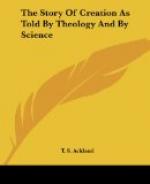This force pervades everything which comes within the cognizance of our senses. It exists in what are termed the elementary substances of which the crust of the earth is composed. A certain amount of it seems to be required to maintain them in the forms in which we know them; for in many cases, when two of them are made to combine, a certain amount of force is set free, which commonly makes its appearance as heat. This seems to indicate that a less amount of force suffices to maintain the compound body than was requisite for its separate elements. Thus, when oxygen and hydrogen are combined to form water intense heat is produced. If we wish to dissolve the union, and restore the oxygen and hydrogen to a gaseous state, we must restore the force which has been lost. This, however, must be done by means of electricity, as heat produces a different change—converting the water into vapour, but not dissolving the union between its elements.
Force, in the shape of heat, determines the condition in which all inorganic bodies exist. In most cases we can make any given element assume the form of a solid, a fluid, or a vapour, by the addition or subtraction of heat. Thus if a pound of ice at 32 degrees be exposed to heat, it will gradually melt—but the water produced will remain unchanged in temperature till the last particle of ice is melted—then it will begin to rise in temperature; and, if the supply of heat be uniform, it will reach a temperature of 172 degrees in exactly the same time as was occupied in melting the ice. Thus then the force which was applied to the ice as heat passes into some other form so long as the ice is being melted—it is no longer perceptible by the senses—we only see its effect in the change from the solid to the fluid form. And this result is brought about by a definite quantity of force. Each of the inorganic materials of which the crust of the earth is composed seems thus to require in its composition a definite amount of force.
The life of vegetables is developed in the formation of fresh compounds of inorganic matter and force. No vegetable can thrive without sunlight, either direct or diffused. This supplies the force which the plant combines with carbon, hydrogen, and other elements to form woody fibre, starch, oils, and other vegetable products. When we kindle a fire, we dissolve the union which has thus been formed—the carbon and hydrogen enter into simpler combinations which require less force to maintain them, and the superfluous force supplies us with light and heat.
The life of animals is developed by a process exactly the reverse of vegetable life. It is maintained by the destruction of the compounds which the vegetable had formed. These compounds are taken into the body as food, and after undergoing certain modifications and arrangements are finally decomposed. Of the force thus set free a part makes its appearance as heat, maintaining an even temperature in the body,




